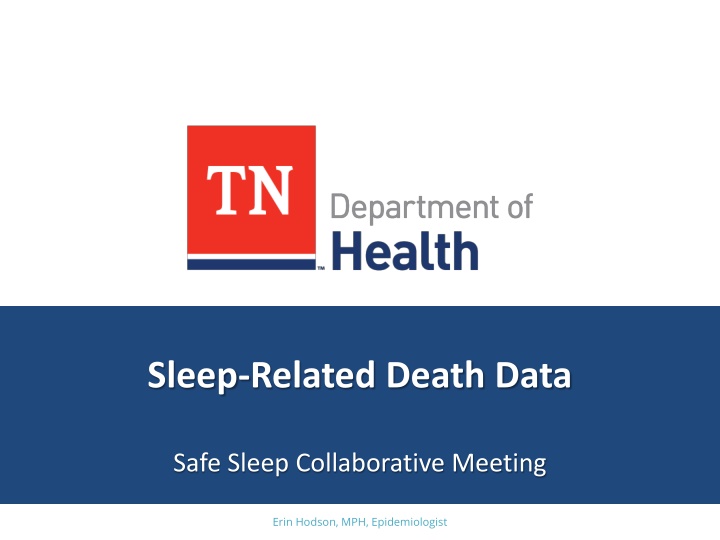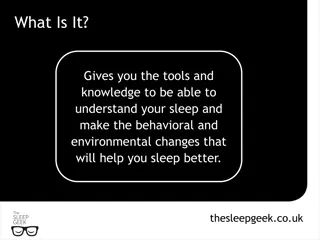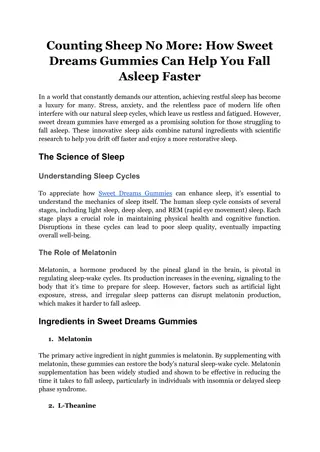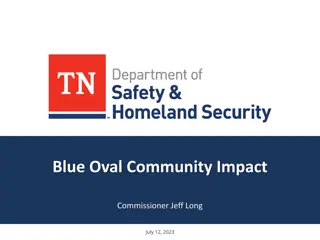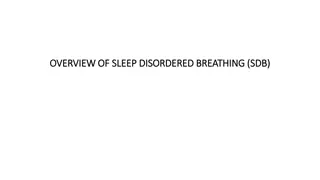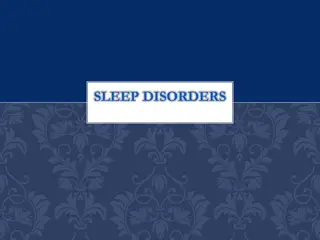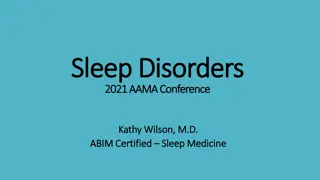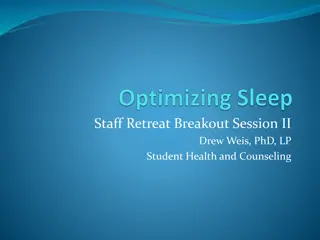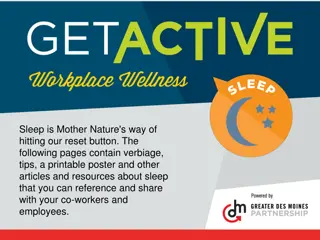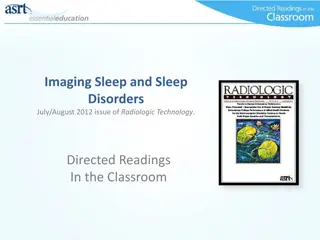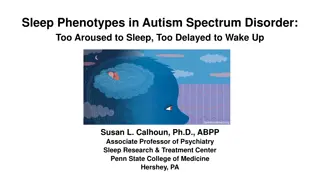Safe Sleep Practices and Data in Tennessee: Insights from PRAMS
Explore safe sleep practices and data related to sleep-related deaths in Tennessee based on the Pregnancy Risk Assessment Monitoring System (PRAMS). Learn about recommended safe sleep behaviors, AAP guidelines, and statistics on baby sleep practices by race/ethnicity. Gain valuable insights to promote safe sleep environments for infants and reduce sleep-related risks.
Download Presentation

Please find below an Image/Link to download the presentation.
The content on the website is provided AS IS for your information and personal use only. It may not be sold, licensed, or shared on other websites without obtaining consent from the author.If you encounter any issues during the download, it is possible that the publisher has removed the file from their server.
You are allowed to download the files provided on this website for personal or commercial use, subject to the condition that they are used lawfully. All files are the property of their respective owners.
The content on the website is provided AS IS for your information and personal use only. It may not be sold, licensed, or shared on other websites without obtaining consent from the author.
E N D
Presentation Transcript
Sleep-Related Death Data Safe Sleep Collaborative Meeting Erin Hodson, MPH, Epidemiologist
AAP Recommended Safe Sleep Behaviors Safe sleep practices recommended by the AAP include: Placing the baby on his or her back at all sleep times including naps and at night. Using a firm sleep surface, such as a safety- approved mattress and crib. Keeping soft objects and loose bedding out of the baby s sleep area. Sharing a room with baby, but not the same bed.
PRAMS Data What is PRAMS? Pregnancy Risk Assessment Monitoring System Purpose: Collect state-specific population- based data on maternal attitudes and experiences before, during and shortly after pregnancy The PRAMS sample is chosen from all women who had a live birth recently, so findings can be applied to the state s entire population of women who have recently delivered a live-born infant PRAMS provides data for state health officials to use to improve the health of mothers and infants.
Safe Sleep Practices by Race/Ethnicity Tennessee, 2017-2018 TN=82% 95% TN=80% TN=58% 95% 100% 85% 76% 80% 74% 70% 66% 61% 60% Percent 41% 40% 20% 0% Baby Most Often Laid on Back to Sleep Baby Always Sleeps Alone Baby Roomshares with Mom Non-Hispanic White Non-Hispanic Black Hispanic Data Source: Tennessee Pregnancy Risk Assessment Monitoring System (PRAMS), 2017 2018; Tennessee Department of Health, Office of Population Health Surveillance; Division of Population Health Assessment. Prepared May 2021 by Division of Family Health and Wellness.
Babys Usual Sleep Place by Race/Ethnicity Tennessee, 2017-2018 100% TN=36% TN=11% TN=44% 80% 61% 60% Percent 50% 45% 45% 40% 34% 27% 16% 20% 14% 9% 0% Twin or Larger Mattress Couch, Sofa, or Armchair Car Seat or Swing Non-Hispanic White Non-Hispanic Black Hispanic Data Source: Tennessee Pregnancy Risk Assessment Monitoring System (PRAMS), 2017 2018; Tennessee Department of Health, Office of Population Health Surveillance; Division of Population Health Assessment. Prepared May 2021 by Division of Family Health and Wellness.
How Baby Sleeps by Race/Ethnicity Tennessee, 2017-2018 100% TN=47% TN=32% TN=9% 80% 58% 60% Percent 43% 42% 37% 40% 20% 19% 20% 11% 10% 8% 0% With a Blanket With Toys, Cushions, or Pillows In a Sleep Sack Non-Hispanic White Non-Hispanic Black Hispanic Data Source: Tennessee Pregnancy Risk Assessment Monitoring System (PRAMS), 2017 2018; Tennessee Department of Health, Office of Population Health Surveillance; Division of Population Health Assessment. Prepared May 2021 by Division of Family Health and Wellness.
Safe Sleep Practices by Maternal Age Tennessee, 2017-2018 TN=80% TN=58% TN=82% 100% 92% 85% 81% 81% 79% 80% 80% 80% 76% 63% 60% 56% 54% Percent 44% 40% 20% 0% Baby Most Often Laid on Back to Sleep Baby Always Sleeps Alone Baby Roomshares with Mom <20 20-24 25-34 35+ Data Source: Tennessee Pregnancy Risk Assessment Monitoring System (PRAMS), 2017 2018; Tennessee Department of Health, Office of Population Health Surveillance; Division of Population Health Assessment. Prepared May 2021 by Division of Family Health and Wellness.
Babys Usual Sleep Place by Maternal Age Tennessee, 2017-2018 100% TN=36% TN=11% TN=44% 80% 60% 54% Percent 46% 45% 44% 40% 39% 40% 35% 31% 20% 12% 11% 11% 10% 0% Twin or Larger Mattress Couch, Sofa, or Armchair Car Seat or Swing <20 20-24 25-34 35+ Data Source: Tennessee Pregnancy Risk Assessment Monitoring System (PRAMS), 2017 2018; Tennessee Department of Health, Office of Population Health Surveillance; Division of Population Health Assessment. Prepared May 2021 by Division of Family Health and Wellness.
How Baby Sleeps by Maternal Age Tennessee, 2017-2018 100% TN=47% TN=9% TN=32% 80% 63% 57% 60% Percent 43% 38% 37% 36% 40% 19% 18% 17% 20% 11% 9% 7% 0% With a Blanket With Toys, Cushions, or Pillows In a Sleep Sack <20 20-24 25-34 35+ Data Source: Tennessee Pregnancy Risk Assessment Monitoring System (PRAMS), 2017 2018; Tennessee Department of Health, Office of Population Health Surveillance; Division of Population Health Assessment. Prepared May 2021 by Division of Family Health and Wellness.
Did Medical Professional Tell You the Following? Tennessee Mothers by Race/Ethnicity, 2017-2018 TN=97% TN=92% TN=58% TN=92% 98% 100% 96% 93% 93% 92% 92% 91% 93% 89% 80% 69% 63% 60% 54% Percent 40% 20% 0% Place Baby on Back to Sleep Place Baby to Sleep in a Crib, Bassinet, or Pack 'n Play Place Baby's Bed in My Room What Should and Should Not Go in Baby's Bed Non-Hispanic White Non-Hispanic Black Hispanic Data Source: Tennessee Pregnancy Risk Assessment Monitoring System (PRAMS), 2017 2018; Tennessee Department of Health, Office of Population Health Surveillance; Division of Population Health Assessment. Prepared May 2021 by Division of Family Health and Wellness.
Did Medical Professional Tell You the Following? Tennessee Mothers by Age, 2017-2018 TN=57% TN=92% TN=97% TN=92% 100% 99% 100% 97% 97% 95% 94% 93% 92% 94% 92% 89% 86% 77% 80% 58% 58% 60% Percent 50% 40% 20% 0% Place Baby on Back to Sleep Place Baby to Sleep in a Crib, Bassinet, or Pack 'n Play Place Baby's Bed in My Room What Should and Should Not Go in Baby's Bed <20 20-24 25-34 35+ Data Source: Tennessee Pregnancy Risk Assessment Monitoring System (PRAMS), 2017 2018; Tennessee Department of Health, Office of Population Health Surveillance; Division of Population Health Assessment. Prepared May 2021 by Division of Family Health and Wellness.
Gap Between Recommended and Actual Behavior: Placing Baby to Sleep on Back Received Recommendation Practices Safe Sleep Behavior 97% Overall 80% 98% Non-Hispanic White 85% 96% Non-Hispanic Black 66% 93% Hispanic 74% 97% <20 76% 99% 20-24 81% 97% 25-34 80% 95% 35+ 80% 0% 20% 40% 60% 80% 100% Percent Data Source: Tennessee Pregnancy Risk Assessment Monitoring System (PRAMS), 2017 2018; Tennessee Department of Health, Office of Population Health Surveillance; Division of Population Health Assessment. Prepared May 2021 by Division of Family Health and Wellness.
Sleep-Related Infant Death
Overall and Sleep-Related Infant Deaths Tennessee, 2015-2019 ~23% of all infant deaths in Tennessee 700 597 597 569 600 563 559 500 Number of Deaths 400 300 200 144 142 139 128 103 100 0 2015 2016 2017 2018 2019 TN Sleep-Related Infant Deaths All TN Infant Deaths Data Source: Tennessee Department of Health, Office of Vital Records & Statistics, Death Statistical System; Tennessee Department of Health, Division of Family Health and Wellness, Child Fatality Review Database. Prepared April 2019 by Division of Family Health and Wellness.
Racial Disparity in Sleep-Related Infant Death Tennessee, 2015-2019 TN Overall White Black 3.5 3.1 3.0 3.0 Rate per 1,000 Live Births 2.8 3.0 2.5 Rate amongst Black infants nearly 4 times as high as rate amongst White infants 2.5 2.0 1.8 1.7 1.7 1.6 1.5 1.3 1.4 1.4 1.4 1.4 1.0 0.8 0.5 0.0 2015 2016 2017 2018 2019 Data Source: Tennessee Department of Health, Division of Family Health and Wellness, Child Fatality Review Database. Prepared May 2021 by Division of Family Health and Wellness.
Infant Age at Time of Sleep-Related Death Tennessee, 2015-2019 25% 21% 19% 20% 16% 15% Percent 12% 12% 10% 7% 5% 5% 3% 2% 2% 1% 1% 0% 0 1 2 3 4 5 6 7 8 9 10 11 Age in Months Data Source: Tennessee Department of Health, Division of Family Health and Wellness, Child Fatality Review Database. Prepared April 2019 by Division of Family Health and Wellness.
Infant Age at Time of Sleep-Related Death Tennessee, 2015-2019 25% 21% 80% of sleep-related infant deaths occurred when infant was under 5 months of age 19% 20% 16% 15% Percent 12% 12% 10% 7% 5% 5% 3% 2% 2% 1% 1% 0% 0 1 2 3 4 5 6 7 8 9 10 11 Age in Months Data Source: Tennessee Department of Health, Division of Family Health and Wellness, Child Fatality Review Database. Prepared April 2019 by Division of Family Health and Wellness.
Rate of Sleep-Related Infant Death by Region Tennessee, 2015-2019 Data Source: Tennessee Department of Health, Division of Family Health and Wellness, Child Fatality Review Database. Prepared May 2021 by Division of Family Health and Wellness.
Where was baby placed to sleep? Tennessee, 2015-2019 Adult bed 53% Crib or Bassinet 22% Couch 10% Other 15% 0% 20% 40% 60% 80% 100% Percent Data Source: Tennessee Department of Health, Division of Family Health and Wellness, Child Fatality Review Database. Prepared May 2021 by Division of Family Health and Wellness.
Where was baby placed to sleep? Tennessee, 2015-2019 Black White 58% Adult bed 49% 17% Crib or Bassinet 24% 12% Couch 10% 14% Other 17% 0% 20% 40% 60% 80% 100% Percent Data Source: Tennessee Department of Health, Division of Family Health and Wellness, Child Fatality Review Database. Prepared May 2021 by Division of Family Health and Wellness.
Contributing Factors in Sleep-Related Infant Deaths Tennessee, 2015-2019 Unsafe bedding or toys in sleeping area 86% Infant found not sleeping in crib or bassinet 74% Infant sleeping with other people 58% Infant found not sleeping on back 50% Infant sleeping with obese adult 13% Drug-impaired adult sleeping with infant 8% Adult fell asleep while breast feeding infant 3% Alcohol-impaired adult sleeping with infant 3% Adult fell asleep while bottle feeding infant 2% 0% 50% Percent 100% Data Source: Tennessee Department of Health, Division of Family Health and Wellness, Child Fatality Review Database. Prepared May 2021 by Division of Family Health and Wellness.
Contributing Factors in Sleep-Related Infant Deaths Tennessee, 2015-2019 Black White 85% Unsafe bedding or toys in sleeping area 86% 78% Infant found not sleeping in crib or bassinet 72% 66% Infant sleeping with other people 53% 49% Infant found not sleeping on back 50% 14% Infant sleeping with obese adult 12% 3% Drug-impaired adult sleeping with infant 11% 2% Adult fell asleep while breast feeding infant 4% 1% Alcohol-impaired adult sleeping with infant 4% 0% Adult fell asleep while bottle feeding infant 3% 0% 20% 40% 60% 80% 100% Percent Data Source: Tennessee Department of Health, Division of Family Health and Wellness, Child Fatality Review Database. Prepared May 2021 by Division of Family Health and Wellness.
Contributing Factors in Sleep-Related Infant Deaths by Region, 2015-2019 Leading Contributing Factor Unsafe bedding or toys in the sleeping area Davidson Shelby Knox Sullivan Northeast East Southeast South Central West Mid-Cumberland Upper Cumberland Infant not sleeping in crib or bassinet Hamilton Madison Data Source: Tennessee Department of Health, Division of Family Health and Wellness, Child Fatality Review Database. Prepared May 2021 by Division of Family Health and Wellness.
Safe Sleep Diaper Bag Data Partnership with Community Health Access and Navigation in Tennessee (CHANT) 652 diaper bags distributed from January 2019-April 2021 Recipients were 34% Black, 60% White Most common age group: 25-34 (42%) Three-fourths (75%) received bag after their infant s birth 68% were covered by TennCare, 15% had no health insurance
Data to Date At follow-up visit Of those that changed their behavior, caregivers reported that they had started placing their baby Alone on a separate sleep surface 93% 54% 66% Only in a crib, bassinet, or pack n' play 60% Reported reading the books and written materials Reported that the items in the bag had caused them to change the way the put their infant to sleep Without soft bedding or toys 55% On their back 52%
Contact Information Ibitola Asaolu, DrPH, MPH, Epidemiologist ibitola.asaolu@tn.gov 615-253-0374 Erin Hodson, MPH, Epidemiologist Erin.Hodson@tn.gov 615-253-2802 29
